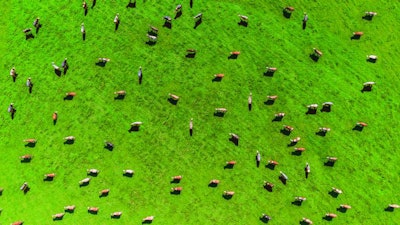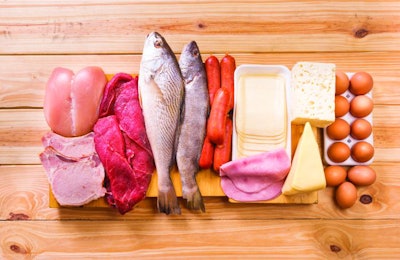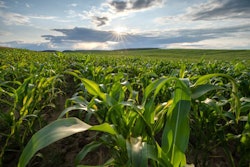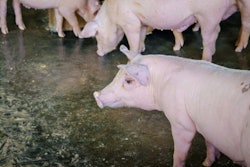
British Society of Animal Science annual conference 2022 centered around animal production’s role in improving human health and its environmental impacts.
In April 2022, the British Society of Animal Science (BSAS) held its annual conference, a hybrid event bringing together scientists, students and industry to discuss the true “Role of Animals in Human and Planetary Health,” entailing dietary, environmental and mental health.
Misguided dietary recommendations
The president’s session focused on the key theme of the conference: the roles of animals in planetary and human health. Chaired by professor and outgoing BSAS president, Michael Lee, this session saw four globally recognized speakers discussing the facts about animals and their contribution to humans and the planet.
Professor Jennie Macdiarmid, a professor of sustainable nutrition and health at the University of Aberdeen, discussed the fact that reducing environmental impact is not as simple as just eating less meat: How healthy and environmentally sustainable are the alternatives?
Referring to the United Kingdom’s committee on climate change’s recommendation of reducing meat and dairy consumption by 20% by 2030, she commented that the situation is not as simple as that, and other aspects, such as potential mineral deficiencies, social influences and the desire for convenience all play a part. Many plant-based alternatives to meat and dairy require fortification with nutrients that would naturally be found in the latter and a large proportion of the plant-based products are highly processed, with vegan meals tending to be high in salt and more expensive than their omnivorous counterparts.
The cautionary tale is that types of plant-based foods are actually taking us back from a health perspective due to their nutrient profile, a sentiment echoed by Professor Alice Stanton, professor of cardiovascular pharmacology at the Royal College of Surgeons, Ireland and director of human health at Devenish.
Stanton said nutritional issues represent one of the biggest killers globally and that meat and milk consumption is at its lowest in areas with the greatest hunger and malnutrition. She also highlighted that the most recent Global Burden of Disease (GBD) report significantly underestimated the benefits of milk and dairy product consumption.
Interestingly, when looking at the EAT-Lancet diet, Professor Frédéric Leroy, professor of food science and (bio)technology, Vrije University in Brussels, commented that red meat is presented as harmful as sugar and, from a climate perspective, the only countries within the “climate boundary for that diet are India and Indonesia – countries that exhibit 30-40% childhood stunting.”
 Plant-based animal protein alternatives often have greater negative health and environmental downsides than their traditional counterparts. (nehopelon | iStock.com)
Plant-based animal protein alternatives often have greater negative health and environmental downsides than their traditional counterparts. (nehopelon | iStock.com)Animal ag environmental concerns explored
The prestigious Hammond Memorial Lecture, sponsored by the Centre for Innovation Excellence in Livestock, was delivered by Professor Phil Garnsworthy of the University of Nottingham, U.K., whose talk centered on how animals can provide solutions to human problems. He highlighted that, for centuries, production animals have provided humans with essential nutrients and other benefits but have recently become demonized in the media. Much of this has been derived from misinformation and a significant use of visual marketing and deliberate scaling of figures to infer negative impacts of animal-sourced food.
The greenhouse gas (GHG) debate was front and center, and Garnsworthy used facts to put the situation into perspective, as well as demonstrate the scale of the problem animal producers face. One of the most simple facts he presented was that, proportionally, agriculture only accounts for 9% of total GHG in the U.K. (around 11% worldwide), so reducing meat intake will have a relatively insignificant effect on total GHG emissions.
Coupled with this, he cited the fact that 86% of livestock feed is not edible for humans. Only one-third of grasslands would be suitable for crop production and a significant proportion of milling cereals don’t make the grade for human food (certainly in the U.K.). Additionally, the carbon footprint inventory for livestock doesn’t include sequestration, but this has a major impact on the sustainability of grazing systems in places like Ireland. That said, Garnsworthy noted that there was interaction between factors affecting efficiency in production systems and the resultant GHG emissions.
The “Net Zero – Next Generation Feed” session addressed the role of feed and feeding technologies in sustainable animal production. Two keynote speakers discussed specific feed technologies and one of the most important aspects of ruminant livestock feeding: forage.
Dr. Saheed Salami, research fellow at Alltech, spoke about the role of feeding technologies, including slow-release nitrogen, chelated minerals and manna-rich fragments in delivering multiple sustainability benefits including the mitigation of greenhouse gas emissions and nutrient pollutions (particularly nitrogen and phosphorus), lower land use and water footprint, improved protein production efficiency, reduction of food loss and waste, lower trace mineral excretion, and reduction of antibiotic use.
To this end, his take-home messages were that a systems approach was needed and that no single product is a silver bullet. Good data are required for a holistic view of sustainability and green labeling provides an opportunity for storytelling and brand reputation for the livestock industry.
Dr. Dave Davies, director of Silage Solutions, presented data on the impact of forage on sustainability. He highlighted that, in the U.K., data suggest greater than 85% of milk production is from cows fed silage rather than grazed grass. Ultimately, this means silage losses affect production sustainability. He emphasized that better knowledge exchange (KE) was required to alter producers to the link between sustainability and crop quality at harvest, as well as a how to manage those losses. Reviewing silage inoculant data, Davies showed that better KE was needed for farmers to fully understand the differences between products. Plant breeding for improved silage-making traits, such as reduced protein degradation and more rapid wilting, was also something he advocated.
Dairy rations examined
In other sessions, researchers noted that, provided diets are carefully formulated, dairy farmers can reduce the level of crude protein (CP) in the diets of high-yielding dairy cows without negative impact on performance.
One study investigated the effect of three total dietary CP levels, 15%, 16% or 17%, on performance of dairy cows fed a total mixed ration. There was no effect of CP level on dry matter intake (DMI), milk yield or composition, but milk urea nitrogen decreased as dietary CP level decreased. Additionally, serum urea and total protein content was higher in animals fed a dietary CP level of 17%. The authors concluded that reducing dietary CP from 17% to 15% improved nitrogen use efficiency without negatively affecting performance. Along similar lines, reducing dietary CP had no negative effect on nitrogen retention in growing dairy Holstein heifers. At the same time, increasing dietary CP can significantly increase urinary nitrogen excretion. In transition cows, Professor Jean Margerison, University of Nottingham, noted that cows offered essential oils pre-partum and essential oils with biotin pre- and post-partum, had increased energy-corrected (EC) milk, milk fat and solids yield, as well as milk protein yield per kg DMI. Additionally, these animals showed reduced daily methane emissions per kg EC milk.
Previous research has shown that many cows experience short-term feed restriction for various reasons, including restricted or insufficient access to feed. When cows finally get access to feed, there is a risk of subacute ruminal acidosis, potentially compromising the rumen microbiome. In a study presented in the dairy nutrition and feed Session, animals were restricted to 75% of their intake for one day followed by a day offered 125% of their normal intake. Rumen samples revealed that, after feed restriction, there was an increase in the relative abundance of operational taxonomic unit associated with Methanobrevibacter. The rumen microbial community had not fully recovered within 12 hours of feed reintroduction, indicating short-term feed restriction may cause longer-term changes.
Precision nutrition for productivity
In a session dedicated to precision livestock farming, researchers modeled impacts of precision livestock farming (PLF) tools on carbon footprints of a suckler beef system. Parameters affected by introduction of technology were considered, including age and weight at slaughter, kill-out percentage, age at first calving, number of calves born and reared, cow and calf mortality, and live weight gain. Associated changes in other aspects of the production system, such as land needed for homegrown feed and bedding, and manure were also included in each scenario. The model output showed that PLF use on-farm resulted in reduced emissions (total farm and per unit of product) and technologies designed to improve health and welfare showed greatest reductions, likely driven by reductions in mortality and improvements in live weight gain leading to reduction in slaughter age in the scenario.
In the youngstock session, Margerison said herd health plans aim to enhance animal health and lower morbidity and mortality. She stated that this, together with good nutritional management, increases growth rate and the proportion of animals that achieve timely maturity targets. She also highlighted that challenges to producers include changes in food consumption, as well as consumer perception, the latter fueled by a lack of understanding of the importance of livestock in sustainable land use.
Following on from this, another study highlighted the importance of managing lower-birthweight dairy calves separately as they experienced more challenges over the pre-weaning period, as well as reduced average daily gains. This allows for farmer intervention to minimize health challenges and support growth.
In a study assessing the effect of foster-cow rearing on dairy calf growth and health, researchers saw better health scores for calves that had been foster-cow reared during the milk feeding period with no negative impact on growth. Despite some significant interactions with time, the authors conclude that foster-rearing may be a suitable alternative method to rear dairy calves and may even reduce environmental footprint of calf rearing due to improved health of calves during the milk feeding period.
It is beyond the scope of this article to summarize all the information and material presented at the conference, as the BSAS annual conference covers a host of relevant topics and production animals. Cutting-edge science relating to non-ruminants, companion animals, equids and aquaculture is annually showcased. More information can be found at www.bsas.org.uk.
References available upon request.

















